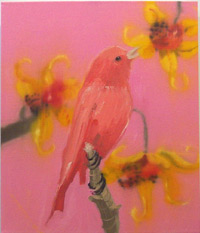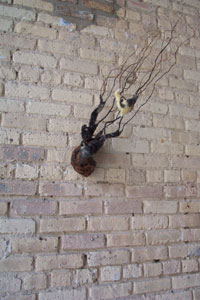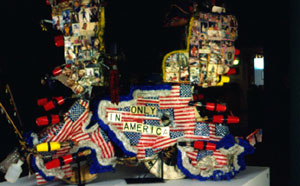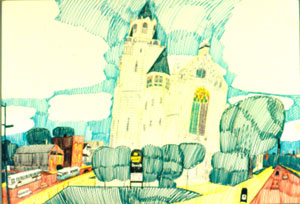By AUDREY MICHELLE MAST
Glossing
at 1R Gallery
In an examination of surface and superficiality in contemporary art, tiny but impressive 1R Gallery assembled some of the shiniest work imaginable, including a life-size photographic portrait of an allover-tattooed, bikini-clad woman by Amanda Ross-Ho as well as Craig Doty’s sleek, gorgeously lit photographs of adolescent boys scrapping with each other. The most stunning thing, however, was a sculptural installation by Diana Puntar called “The Sunnyside Collection” (her titles deal with the “implied idealism” of cities’ names). These laminate-on-wood cubes, embellished with mirrored panels and yellow circles, looked like minimalist ’70s furniture, but with a deliciously tawdry edge.
![]()
Mixer 03: An Ornithological Group Show of Work in All Media
at moniquemeloche
 A
few happy coincidences led to a full-blown festival of feathers
at
A
few happy coincidences led to a full-blown festival of feathers
at Monique Meloche’s epononymous gallery. Highlights included
a wall-mounted sculpture by Los Angeles-based artist Carlee
Fernandez, who altered taxidermied fuzzy little birds so their
wings and legs extended directly into twisting tree branches.
The result was a little grotesque, a little sad, and completely,
bizarrely beautiful. Lane Hall and Lisa Moline installed gigantic
laser prints of decaying birds on an entire wall, emphasized
by punchy latex paint in sorbet colors. In stark contrast,
Ann Craven’s small, sugary-sweet painting of a small
salmon-colored bird surrounded by yellow flowers was astonishingly
pretty. A few artists’ work was indirectly about birds,
like Guy Hundare’s video “Ornithomancy,”
in which computer-generated airplanes swooped silently and
gently through a void, and Pamela Wilson’s oil on linen
painting “Aviary,” a lonely, haunting grid of
bars and bare trees.
Monique Meloche’s epononymous gallery. Highlights included
a wall-mounted sculpture by Los Angeles-based artist Carlee
Fernandez, who altered taxidermied fuzzy little birds so their
wings and legs extended directly into twisting tree branches.
The result was a little grotesque, a little sad, and completely,
bizarrely beautiful. Lane Hall and Lisa Moline installed gigantic
laser prints of decaying birds on an entire wall, emphasized
by punchy latex paint in sorbet colors. In stark contrast,
Ann Craven’s small, sugary-sweet painting of a small
salmon-colored bird surrounded by yellow flowers was astonishingly
pretty. A few artists’ work was indirectly about birds,
like Guy Hundare’s video “Ornithomancy,”
in which computer-generated airplanes swooped silently and
gently through a void, and Pamela Wilson’s oil on linen
painting “Aviary,” a lonely, haunting grid of
bars and bare trees.
![]()
Politics as Usual
at Aron Packer
An overwhelming number of artists were packed into the gallery for this politically-themed show, including Brian Dettmer, who modified prerecorded sound bites from George W. Bush which play on a giant iPod. Also featured were Sean Sorensen’s homemade burqas fashioned from American materials like denim or corporate-logo printed fabric; and counterfit stamps by Michael Hernandez de Luna, sent through the U.S. Postal Service and exhibited on their postmarked envelopes (one set features Chairman Mao in an Elvis suit). An arresting large-scale installation by Freise Undine of hundreds of small portraits of world leaders, rendered in a style that mixed the look of propaganda literature and tarot cards, was the focal point of the exhibition.
![]()
Summer
at Bodybuilder and Sportsman
The trio of Leslie Baum, Mark Booth, and Paul Nudd comprised this exhibition of painting, drawing, and video work. Baum’s smallish oil on canvas paintings are, as she describes, “those of the traveler and not the resident” — atmospheric landscapes (trees, mountains, buildings) floating in abstract space, rendered in washed-out pastels paired with Day-Glo colors. Booth, an instructor at SAIC, exhibited an enigmatic collection of enamel on canvas and panel paintings that feature weird juxtapositions of animal names (“Snail Headed Egret,” “Egret Headed Snail”), as well as works on paper. Nudd’s work, also on paper, was a feast of pseudo-organic shapes, including what looked like wormlike entities, cilia, intestines, and cells, rendered in yellows, greens, and browns. In a small adjacent room, a video by Nudd completed the playful gross-out theme: images of shimmering, oozing bubbles — vaguely soapy yet unclean-looking, a conglomeration of milky substances juxtaposed with acid-green ones, all undulating and popping violently by some unseen force.
![]()
Nitty Gritty: Slim’s Bike and the Street Art of Curtis Cuffie and Wesley Willis
at Intuit: The Center for Intuitive and Outsider Art
If you thought “street art”
was just about graffiti, think again. Intuit’s poignant
and witty exhibition of work made from and about the streets featured work by the late James
“Slim” Thompson, New York’s late Curtis
Cuffie, and Wesley Willis from Chicago. In the center of the
gallery sits “Slim’s Bike,” a massive modified
Schwinn that Thompson rode through Detroit’s gritty
Cass Corridor, making himself a neighborhood legend. The bike
is covered with patriotic flags, fur, pinwheels, plastic cups,
and scores of pinup photos of scantily-clad women, which,
like Slim himself, was an eccentric tour de force. Surrounding
Slim’s Bike were assemblages by Curtis Cuffie, who was
homeless for a large part of his life, but gained attention
from students near Cooper Union in New York, where he often
produced sculptural installations on fences. His sculptures
were mostly vertical, often anthropomorphic conglomerations
of discarded objects, like a carpeted cat playhouse mounted
on a coat tree, topped with an old camera case, and a tripod
decked with Christmas
from and about the streets featured work by the late James
“Slim” Thompson, New York’s late Curtis
Cuffie, and Wesley Willis from Chicago. In the center of the
gallery sits “Slim’s Bike,” a massive modified
Schwinn that Thompson rode through Detroit’s gritty
Cass Corridor, making himself a neighborhood legend. The bike
is covered with patriotic flags, fur, pinwheels, plastic cups,
and scores of pinup photos of scantily-clad women, which,
like Slim himself, was an eccentric tour de force. Surrounding
Slim’s Bike were assemblages by Curtis Cuffie, who was
homeless for a large part of his life, but gained attention
from students near Cooper Union in New York, where he often
produced sculptural installations on fences. His sculptures
were mostly vertical, often anthropomorphic conglomerations
of discarded objects, like a carpeted cat playhouse mounted
on a coat tree, topped with an old camera case, and a tripod
decked with Christmas  garland,
scrap fabric, and stuffed toys. In stark contrast to the hodgepodge
feel of Cuffie’s and Thompson’s work, Wesley Willis’
pen-and-marker cityscape drawings on posterboard are linear
and ascetic, but completely engrossing. The drawings shown
here were produced in the early ’90s and are a quick
study in neighborhood change — his obsessive hand rendered
the intersection of Milwaukee, North, and Damen when its main
features were a shoe repair and a donut shop. Willis, who
suffers from schizophrenia, became a well-known Chicago personality
for his sketches as well as his habit of friendly head-butting.
He has also released over 40 albums of songs including the
cult classic “Cut That Mullet.”
garland,
scrap fabric, and stuffed toys. In stark contrast to the hodgepodge
feel of Cuffie’s and Thompson’s work, Wesley Willis’
pen-and-marker cityscape drawings on posterboard are linear
and ascetic, but completely engrossing. The drawings shown
here were produced in the early ’90s and are a quick
study in neighborhood change — his obsessive hand rendered
the intersection of Milwaukee, North, and Damen when its main
features were a shoe repair and a donut shop. Willis, who
suffers from schizophrenia, became a well-known Chicago personality
for his sketches as well as his habit of friendly head-butting.
He has also released over 40 albums of songs including the
cult classic “Cut That Mullet.”